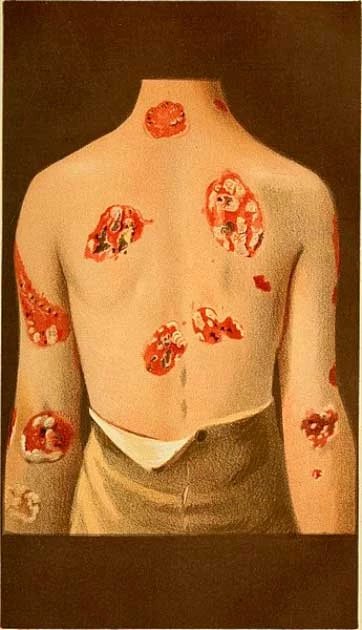The proverb “You can’t make an omelet without breaking some eggs” is fairly straightforward: in order to achieve something, something has to be sacrificed or will be damaged in the process. Medical history is full of people who thought the same thing and so they chose, often unwisely, to experiment on themselves.
There was Max von Pettenkofer, who drank a watery soup full of cholera just to prove his contemporary Robert Koch’s idea that bacteria caused disease was wrong. Unsurprisingly, this didn’t go well.
Stubbins Ffirth decided to prove that yellow fever was not contagious. How did he do that? By pouring the black vomit of someone infected with yellow fever into open cuts and his eyes, drinking the vomit, and frying it to see if the vomit fumes would make him sick.
Ffirth, amazingly, didn’t get sick. Later, it was discovered that the disease was transmitted by mosquitoes. And while these were both useful experimental conclusions, they were perhaps not the wisest course of action either time.
These are just a few of the many doctors or medical practitioners in history who cracked some really gross eggs while chasing the wrong conclusion. John Hunter was one of these self-experimenting doctors who did something disgusting to prove they were right. Here is the story about how John Hunter set medical knowledge back by about 50 years, by being wrong.
John Hunter
John Hunter was a British surgeon born on 13 February 1728 in Long Calderwood near East Kilbride, Scotland. One of John Hunter’s older brothers, William Hunter, was an anatomist who lived in London.
John Hunter visited William in London when he was around 20 or 21 and officially moved to the city. William had become a highly regarded anatomy teacher, and John Hunter soon became his brother’s assistant during dissections. A year after John Hunter became his brother’s assistant, he also began running dissection classes and giving lectures.

William arranged for John Hunter’s entrance into the “top level of London surgery”. This saw John study under two celebrated surgeons, William Cheselden at Chelsea Hospital and Percival Pott at St. Bartholomew’s Hospital.
John became an assistant surgeon and then eventually a full surgeon in 1756 at St. George’s Hospital in Tooting, London. In 1760, John Hunter became an Army surgeon with the British Army. It is worth noting that John Hunter never attended medical college and was not a certified doctor, just a guy whose brother pulled some strings and knew a lot about anatomy.
The other medical contributions to medicine John Hunter made were the role of the lymphatic system, the first recorded artificial insemination in 1790, digestion, inflammation, and gunshot wounds. The gunshot wound discovery was that it was not a good idea to make the entrance wound in a person bigger, as was standard practice, to remove the bullet and clear other debris.
- The Starvation Doctor: Dr. Linda Hazzard’s Deadly Cure
- Heroin Cough Medicine? The Rise and Fall of Patent Medicine
He also helped in understanding how bones grow and how they can be remodeled after injury, teeth, and that a mother and a fetus have two separate blood supplies. Then came his study of venereal diseases…
Trying Out Some Things
By 1767, John Hunter was considered to be THE leading authority on venereal diseases (STDs). At this point, only two STDs were recognized by the medical community: gonorrhea, and syphilis.
London had become a major city with explosive population growth, and more people meant there were more prostitutes. Sailors would arrive already infected with venereal disease, enjoy the company of a prostitute, and leave the lovely lady with a nasty infection which she could then pass on.
John Hunter studied gonorrhea and syphilis and was convinced they were two different stages of the same disease. The medical community disagreed, but John Hunter was so convinced the diseases were the same.
According to his theory gonorrhea is the first stage, and syphilis is the second stage, so he decided to do an experiment to prove it. The trouble was finding someone who 100% did not have either disease who would agree to be infected with gonorrhea to be studied, and that’s when he decided to experiment on himself. Before we continue this disgusting story, it is important to explain the two diseases a bit more.
Gonorrhea and Syphilis
Gonorrhea, or as it is often called, “the clap,” is a very common STD. It is estimated that there are at least 33 million new cases of gonorrhea each year, but some estimates put the figure three times higher.
For men and women, the disease causes swelling, itching, pus, pain when urinating, sore throat, and swollen lymph nodes in the neck. Both genders can be infected with gonorrhea in the rectum, throat, joints, and eyes.
In men, the disease may cause testicular swelling in one or both testicles and a yellow/green discharge of pus from the penis. In women, the disease may cause vaginal discharge, pain in the lower abdomen, or pain during sex.
Untreated gonorrhea in women can lead to scars on the fallopian tubes, which can cause ectopic pregnancies (attachment outside the uterus). If a pregnant woman with gonorrhea is not treated, she can give the baby gonorrhea of the eyes in-utero.

The disease is treated with antibiotics such as azithromycin. Unfortunately, at the time of John Hunter’s experiment, antibiotics did not exist: penicillin would not be discovered until 1928. What was used to treat gonorrhea instead was mercury, a medical wonder drug but also a highly toxic poison.
Syphilis however is extremely deadly, and before antibiotics, contracting syphilis was a death sentence. Doctors also treated it with mercury, seemingly the best cure-all for all ailments of this type at the time.
There are four stages of syphilis, and each has its own symptoms. Primary syphilis is the first phase, and it causes a small sore known as a chancre (pronounced SHANG-kur), a hard painless ulcer on the genitals. Sometimes you will hear people call these “Hunterian chancres,” which got their nickname from John Hunter and his experiment.
The next stage is Secondary syphilis which causes a rash on your torso that spreads to the entire body, including the palms of the hands and soles of the feet. The rash is typically not itchy, but it can come with wart-like sores in the mouth or genitals.
- Jaw-Droppingly Awful? The Radioactive Medicine of the 1920s
- Silas Weir Mitchell and the Rest Cure: Brilliant Doctor or Cruel Tyrant?
Additional symptoms of Secondary syphilis include hair loss, fever, muscle aches, and sore throat. The third stage is Latent syphilis, where you blessedly experience no further symptoms.
The final stage is Tertiary syphilis, and this can cause damage to the brain, nerves, liver, joints, bones, heart, and blood vessels. If left untreated, the disease can spread to the brain, eyes, and ears.
If it affects your brain, it can cause muscle weakness and changes to your mental state, such as difficulty focusing, confusion, personality changes, and dementia. The cure for syphilis today is antibiotics, but they are unable to undo any damage the disease has already caused.
The Gross Part
I apologize in advance for this because it is going to get super gross for a bit. John Hunter had a patient who had yellow penile discharge, a sign of gonorrhea, and Hunter collected some samples of this patient’s pus.
Then, to infect himself, he made some cuts on his penis and applied the pus to the open wounds. Within days, John Hunter began to experience pain and eventually developed some other symptoms of gonorrhea. Now all he had to do was wait, record his condition, and see when it would turn into syphilis.
And to his sheer delight, John Hunter found he had begun to develop symptoms of syphilis! In a time before the concept of confirmation bias was recognized, according to John Hunter’s test, it looked like his belief that gonorrhea evolves into syphilis.

As a fellow of the Royal Society of London for Improving Natural Knowledge, now known as the Royal Society, John Hunter had a significant role in medical knowledge at the time, and what his results proved became widely accepted. Sadly they were also erroneous and based on inaccurate observations, but by the time this had been corrected Hunter had set medicine back about 50 years.
Turns Out They Are Different
Gonorrhea and syphilis are two different sexually transmitted diseases, and John Hunter was so very, very wrong. But how did he start with gonorrhea and end with syphilis? It turns out the patient, John Hunter acquired the pus from had both gonorrhea AND syphilis!
When the sample was collected, Hunter only identified the signs of gonorrhea. This may have occurred because the patient was most likely in the third phase of syphilis, the latent stage. The self-experiment proved that John Hunter was not an actual doctor and that he infected himself with one incurable disease as well as another where consuming and rubbing mercury on your body was the only “cure”.
John Hunter dropped dead at age 65 while at a meeting in 1793 about the admission of apprentices at the hospital. He died from an aortic aneurysm, a heart attack, which many believe was possibly caused by Hunter developing the final stage of syphilis.
Due to Hunter’s “successful experiment” showing gonorrhea and syphilis are the same, both diseases were believed to be the same by the medical community until 1838. French physician, Philipe Ricord, proved that syphilis and gonorrhea were two different diseases.
Somehow Hunter’s self-experiment didn’t affect his legacy, and he is seen today as an influential figure in the history and development of modern science rather than a crazy person who cut his own penis and accidentally gave himself syphilis.
Top Image: John Hunter made many advances in human understanding of medicine but some of his experiments, such as when he infected himself with syphilis, were less fortunate. Source: After Joshua Reynolds / CC BY 4.0.